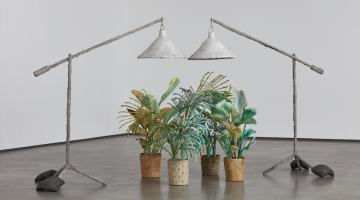Can form become movement? The hulking, ceramic forms in John Mason’s exhibition, “Crosses, Figures, Spears, Torques” at David Kordansky Gallery in Los Angeles call to mind many of the works of the Merce Cunningham Dance Company. Some tall and some squat, it is the combination of rotated, twisted, and symmetrical slab-formed sculptures that most act to remind me of the of Cunningham dance. There is force being represented and played with in Mason’s large singularities; the forms bend around a central axis, like dancers bodies, they stand united on the plinth in silhouette, and hold a position each differently. In Cunningham dances there was often a period in the dance where many dancers together were performing a different movement, or even a slight variation on a movement. The dancers existed on the stage at different strata, some moving across the ground on all fours, some leaping in the air. Cunningham’s dances, were often performed on a simple floor or stage, and were notably without props or sets. One often watched the dancers perform on a floor only separated from an audience by the few inches of a simple stage or the taped lines on the floor itself.

Exhibition installation view, Crosses, Figures, Spears, Torques, David Kordansky Gallery.
Courtesy of the gallery.

Exhibition installation view, Crosses, Figures, Spears, Torques, David Kordansky Gallery.
Courtesy of the gallery.
In this same way, Mason’s forms are acting simultaneously on each other on this large, single plinth. When approaching the plinth from the right, one stands closest to a tall, straight-edged slab work, glazed with a complicated royal blue with iron undertones, “Vertical Intersection, Blue”. This work stands at the opposite side of the plinth from the shortest work, which is a golden yellow-glazed, bent, and folded work called, “Folded Cross, Yellow-Gold”. These two works appear to have the same total volume, and yet they occupy a different form in space. Their opposite qualities tie them together. “Vertical Intersection Blue” points upward, perpendicular to the plane of the plinth, while “Folded Cross, Yellow-Gold” appears to direct your attention to every other direction, except vertically, and every other work on it’s shared stage. Like the complicated sequences and simultaneity of Cunningham’s dances where some dancers were engaged in plays of force with each other and some were acting in solo moments, “Vertical Intersection Blue” acts as a solitary form and “Folded Cross, Yellow-Gold” appears to be hunched, reflective, and yet social.
It is also Mason’s treatment of the surface of the sculptures, his glazes, that ride smoothly down the angular forms, not unlike the Cunningham costumes, that are used to bring a sheer color streak to the dominant, muscular forms. The costumes were not used to mask the bodies, or change their shape. Mason’s glazes adhere tightly to the form, a satin layer that reveals the seeming movement within the strong sculptures, made by the fitness between the glaze chemistry and the clay body.
Good sculpture is specific in space. It is the specificity of each movement of each piece that turns the entire exhibition into an opportunity in which works affect each other. Mason’s forms have been described as figurative, and for more reasons than simply their scale. In their pursuit of something rarely-attainable, both Mason and Cunningham’s work seem guilty of a particular machoness, but that is quickly balanced by the sincerity in their forms. There are also subtle and dainty movements in both their work that undo the constant heaviness and seriousness of what they are communicating to you. This show is a hot crossover between form, space, movement, surface, performance, and symmetry.
For more information John Mason’s exhibition, “Crosses, Figures, Spears, Torques” visit David Kordansky Gallery, Los Angeles.
-Contributed by Cathy Fairbanks







